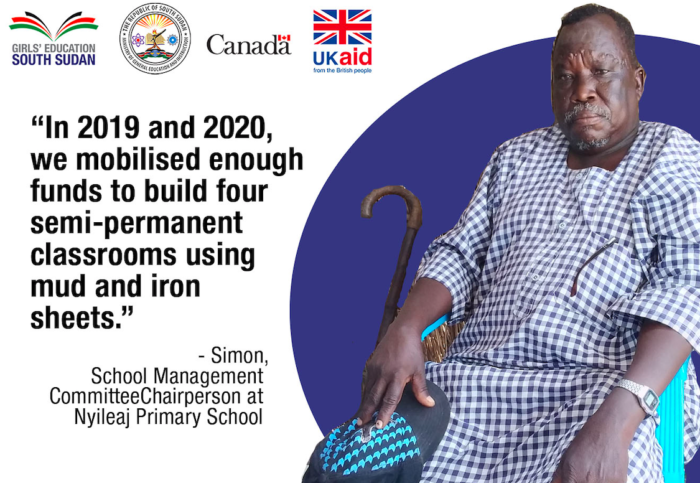School Management Committee Mobilises Funds for School Improvement
June 11, 2021 9:50 amIn South Sudan, teachers receive a very low monthly salary. A teacher in pay grade 14 receives a monthly salary of about 1,150 South Sudanese Pounds (SSP). This is less than 9 USD. As a result, many trained teachers have been leaving the teaching profession for better-paying jobs, forcing schools to recruit untrained and unqualified volunteer teachers who are placed in lower salary grades. Coupled with the deteriorating purchasing power of the South Sudanese Pound (SSP), the monthly salary of a teacher is barely enough to feed a family for two days.
A common practice is for parents and guardians to supplement the salaries of volunteer teachers. However, since the political crisis that broke out in December 2013, many parents and guardians in the Greater Upper Nile region rely on food aid from humanitarian partners, with little money to spare.
Manyo County has been heavily affected by the political crisis since 2013. The Girls’ Education South Sudan (GESS) programme was re-introduced in the Manyo County in the year 2018 after calm was restored. Due to the severity of the fighting, most of the schools were closed until 2019 when six schools reopened. This number increased to seven schools in 2020 and at the time of writing this document, 15 schools are due to reopen at the beginning of May.
Schools in Manyo County continue to benefit from the GESS programme, with more girls qualifying for Cash Transfers, and schools for Capitation Grants, every year. However, teachers continue to receive low and irregular salaries. For example, the salary for September 2020 was paid in March 2021, and most of the teachers were paid 1,200 SSP, as they are untrained and therefore categorised in the lowest pay grade.
Simon Bol Ajing is a former Member of Parliament for the now-defunct Fashoda State. He was elected as the chairperson of the School Management Committee (SMC) for Nyileaj Primary School in Manyo County in 2018 – the same year that GESS was re-introduced in the County. He became deeply troubled by the low and irregular salaries paid to volunteer teachers after witnessing the teachers struggle to support their own families, month after month.

When Simon was elected as the SMC Chairperson, he received a briefing from a GESS School Officer on how to complete the School Development Plan and Budget Pack to receive the Capitation Grant – funds made available to all not-for-profit schools (government, community, and faith-based schools) to help them to supplement running costs and improve the learning environment. The training ignited a fire in Simon. He realised that the SMC had an opportunity to spend the Capitation Grant effectively and a responsibility to raise more funds for the school. During SMC meetings, Simon would apportion a set time to discussing community fundraising.
The School Management Committee (SMC) agreed to prioritise the following:
- Payment of incentives for volunteer teachers.
- Procurement of teaching and learning materials, as well as recreational materials.
- Building additional semi-permanent classrooms to add to the two classrooms built by the government.
The SMC explained the function and impact of the GESS Capitation Grants to community members, showing the level of development that could be achieved through the effective use of the money. Community members were shown a clear plan for the further development of the school and asked to contribute whatever they were able to. Through careful planning, the SMC members garnered support from several different sources in the community:
- Each family in the vicinity of the school contribute 15,000 SSP for education annually.
- Local fishermen and boat owners are tasked with raising an annual sum of 1,000,000 SSP for education.
- A monthly fee is collected from those coming into the area for cattle grazing.
- People cutting grass contribute 20% of their earnings to education.
- A vegetable garden was prepared for the school and the produce was used for school feeding. Leftover income is sold and used for educational development.
“After the meeting, I started mobilising each of the groups to fulfil their commitment. In 2019 and 2020, we mobilised enough funds to build four semi-permanent classrooms using mud and iron sheets. We also managed to pay nine teachers a monthly salary of 5,000 SSP per month in 2019 and 10,000 SSP per month in 2020.” Simon notes that the teachers are much more motivated, and he believes that the quality of teaching has improved significantly.
The school has come far under Simon’s effective leadership. His commitment shows how far a school can go if the school management and school community take ownership. Simon now dreams of equipping the school with solar panels and an IT room so that the teachers and learners can access the internet for improved learning opportunities.
To receive a Capitation Grant, schools must submit a simple School Development Plan and a School Budget that details out how the school will spend the money. 5,317 schools across South Sudan had submitted their Schools Development Plans and Budgets for Academic Year 2021 by mid-April.
To find out more about Capitation Grants, go here.
Categorised in: Capitation Grants, Human Interest Story